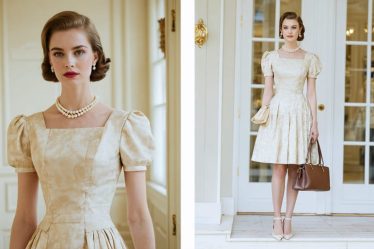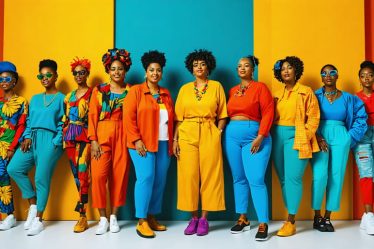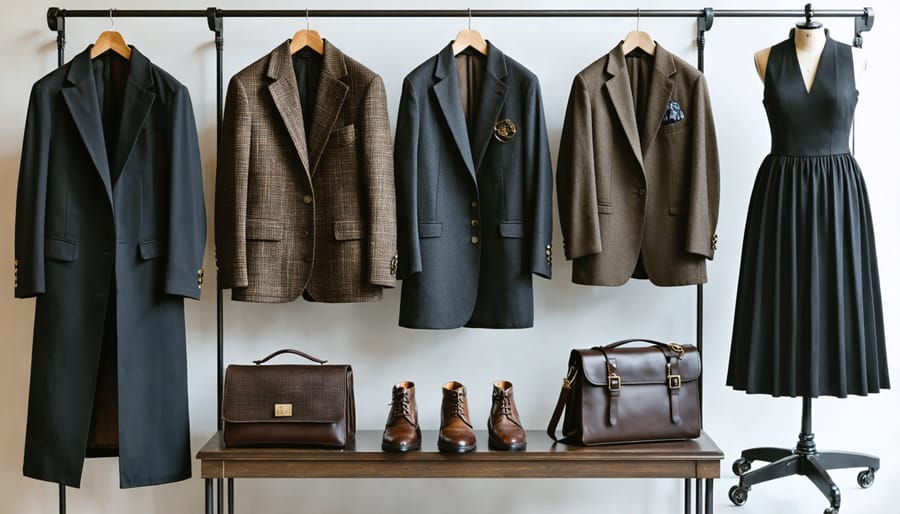
Vintage clothing transcends fleeting trends, offering a unique pathway to sustainable fashion that lasts while telling stories through carefully preserved pieces. These timeless garments bring character to modern wardrobes, combining historical charm with contemporary style sensibilities. From perfectly worn-in Levi’s from the ’70s to elegant silk blouses from the ’50s, vintage pieces carry an authenticity that mass-produced fashion simply cannot replicate.
Beyond their aesthetic appeal, vintage clothes represent a conscious choice to step away from fast fashion’s environmental impact. Each rescued piece prevents another garment from entering landfills while celebrating the superior craftsmanship of bygone eras. Whether you’re drawn to the bold patterns of the ’60s, the refined tailoring of the ’40s, or the relaxed elegance of the ’90s, incorporating vintage pieces into your wardrobe creates a signature style that’s both environmentally responsible and uniquely personal.
As more fashion enthusiasts embrace sustainable wardrobes, vintage clothing has evolved from a niche interest to a powerful statement about individual style and environmental consciousness. These enduring pieces don’t just complement modern fashion – they elevate it, proving that true style never goes out of date.
Why Vintage Fashion Stands the Test of Time
Superior Construction Techniques
When you pick up a vintage piece from the 1950s or earlier, you’ll often notice the incredible attention to detail that went into its creation. I remember finding my grandmother’s old wool coat and being amazed by the hand-finished buttonholes and perfectly matched patterns at the seams – details that are rarely found in today’s fast fashion.
Vintage garments typically feature techniques like French seams, which enclose raw edges completely, preventing fraying and extending the garment’s life. Hand-sewn linings, reinforced stress points, and generous seam allowances made alterations easier and ensured clothes could be passed down through generations.
The quality of vintage fabrics is equally remarkable. Natural fibers like silk, wool, and cotton were standard, and these materials were often more densely woven than their modern counterparts. Designers also considered the drape and weight of fabrics carefully, creating garments that moved beautifully and maintained their shape.
These superior construction methods explain why so many vintage pieces have survived decades of wear while maintaining their beauty and structural integrity – a testament to the craftsmanship of yesteryear.
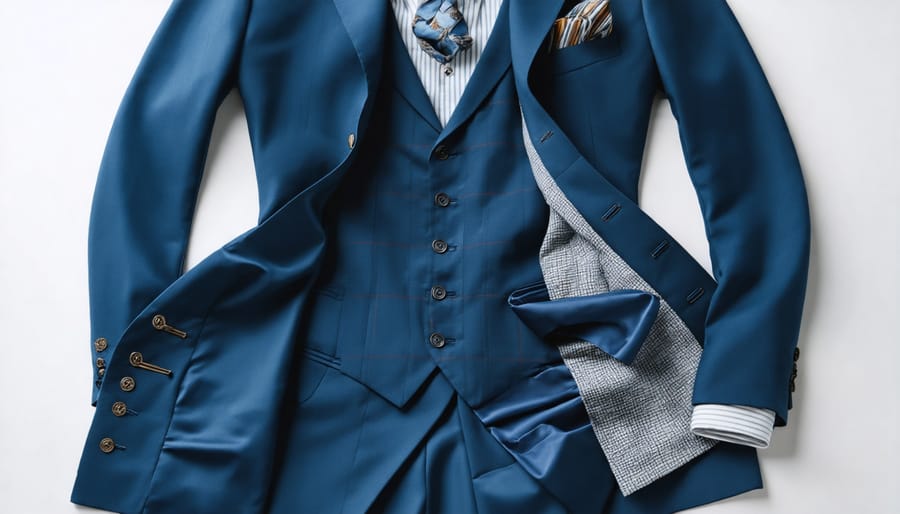
Classic Design Elements
When it comes to vintage clothing, certain design elements have stood the test of time, becoming what we now consider timeless fashion secrets. A-line skirts that gracefully skim the hips, well-tailored blazers with defined shoulders, and high-waisted trousers remain eternally chic. These classic silhouettes flatter various body types and transcend seasonal trends.
Patterns play an equally important role in vintage aesthetics. Polka dots, especially in navy and white, convey playful sophistication, while herringbone and houndstooth prints add texture and visual interest to any outfit. Florals, particularly small-scale prints from the 1940s and delicate Liberty-style patterns, continue to charm fashion enthusiasts decades later.
I’ve found that vintage pieces with these timeless elements are the ones that integrate most seamlessly into modern wardrobes. A 1950s pencil skirt or a 1970s wrap dress with clean lines can look just as fresh today as when they first appeared. The key is focusing on pieces with balanced proportions and versatile design elements that complement, rather than overwhelm, your personal style.
Building Your Vintage Capsule Wardrobe
Essential Vintage Pieces Every Wardrobe Needs
When it comes to build your perfect wardrobe, certain vintage pieces stand the test of time and bring timeless elegance to any outfit. Here are the must-have vintage items that deserve a place in your closet.
First on the list is the iconic vintage blazer, preferably from the 1980s or 1990s. Look for classic patterns like herringbone or houndstooth, which pair beautifully with everything from jeans to dresses. I found my favorite vintage blazer at a local thrift store, and it’s become my go-to piece for instantly elevating any outfit.
A well-preserved vintage Levi’s denim jacket is another essential. These jackets actually improve with age, developing a beautiful worn-in patina that’s impossible to replicate with new pieces. Style it over summer dresses or layer it under wool coats during colder months.
Don’t overlook accessories – a structured vintage leather handbag adds sophistication to any ensemble. Brands like Coach and Dooney & Bourke from the 1990s offer incredible quality and timeless design at fraction of today’s prices.
For special occasions, a little black dress from the 1960s can be your secret weapon. The quality of construction and unique details like covered buttons or intricate seaming make vintage cocktail dresses truly special. Style them with modern accessories to create a perfect balance between old and new.
Finally, invest in a classic trench coat. Vintage Burberry or London Fog pieces are particularly sought-after for their superior craftsmanship and distinctive details. These pieces work seamlessly with both casual and formal outfits, making them true wardrobe workhorses.
Mixing Vintage with Contemporary Fashion
The beauty of vintage fashion lies in its ability to blend seamlessly with modern pieces, creating unique looks that tell your personal style story. I remember discovering this magic when I paired my grandmother’s 1960s brooch with a contemporary blazer – the compliments I received that day showed me how powerful these combinations can be.
To create balanced looks, start by treating vintage pieces as statement items. A classic 1950s full skirt pairs beautifully with a modern fitted turtleneck, while vintage Levi’s can look fresh with a crisp white button-down and current-season accessories. The key is to avoid wearing too many vintage pieces at once, which can make your outfit look costumey rather than curated.
Consider proportions carefully – if you’re wearing a loose vintage blouse, balance it with modern slim-fit pants. For those just starting to mix vintage with contemporary pieces, accessories are your best friends. A vintage silk scarf can transform a simple modern dress, while a contemporary belt can give new life to a vintage coat.
Don’t be afraid to play with unexpected combinations. A delicate 1940s dress can look surprisingly current when paired with modern sneakers and a leather jacket. The most successful vintage-contemporary looks often come from breaking traditional rules while maintaining a cohesive color palette and silhouette.
Remember, the goal isn’t to recreate a specific era but to incorporate beautiful pieces from the past into your modern wardrobe in a way that feels authentic to your personal style.
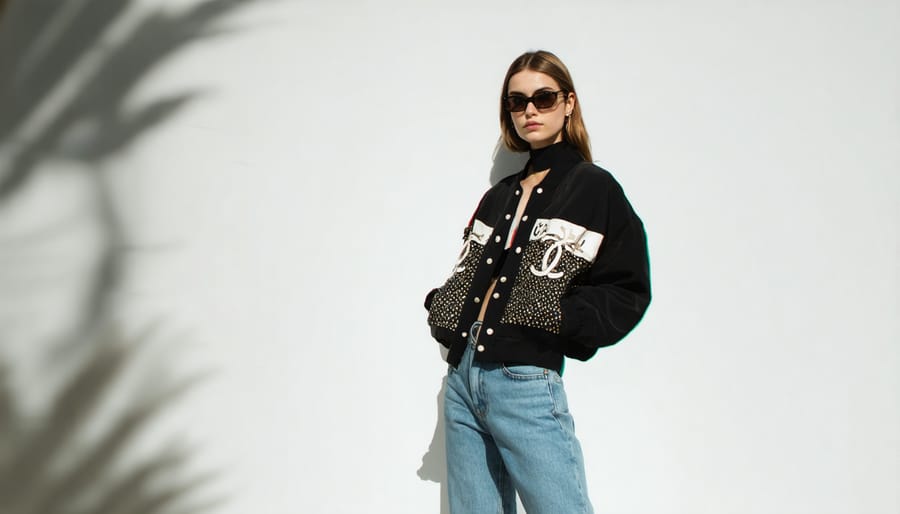
Shopping Smart: What to Look For
When hunting for vintage treasures, the key is knowing what signals quality and authenticity. Start by running your hands over the fabric – quality vintage pieces often feature natural materials like silk, wool, or cotton with a substantial feel. Check the garment’s seams; they should be straight and secure, with no obvious repairs or loose threads.
Look for labels and tags, as they can tell you a lot about a piece’s age and origin. Original labels from well-known designers or manufacturers are particularly valuable. Pay attention to zippers – metal zippers were common in older garments, while plastic ones typically indicate newer pieces.
Examine the overall condition carefully. Some wear is expected with vintage items, but watch out for irreparable damage like deep stains, moth holes, or fabric deterioration. Don’t forget to check for that distinctive vintage design aesthetic – features like covered buttons, hand-finished details, and unique silhouettes often indicate authentic period pieces.
Remember that sizing has changed over the decades, so always try items on or measure them against your existing clothes. Trust your instincts – if something seems off about the age or authenticity of a piece, it probably is.
Caring for Your Vintage Treasures
Cleaning and Storage Solutions
Taking care of vintage clothing is like preserving little pieces of fashion history. I learned this the hard way when I accidentally ruined a 1950s silk blouse by tossing it in the washing machine – trust me, you don’t want to make the same mistake! Let me share some tried-and-true methods for keeping your vintage treasures in pristine condition.
For cleaning, always check the fabric content first. Most vintage pieces benefit from hand washing with mild, pH-neutral detergent in cool water. For delicate items, consider spot cleaning or seeking professional dry cleaning services that specialize in vintage garments. Remember to test any cleaning solution on a hidden area first.
Storage is equally crucial. I recommend using padded hangers for structured pieces and storing delicate items flat in acid-free tissue paper. Keep your vintage clothing away from direct sunlight and in a cool, dry place to prevent fabric deterioration. For special pieces like beaded gowns or fur coats, breathable garment bags are your best friends.
Moths can be particularly destructive to vintage fabrics. Instead of mothballs (which can be harmful), use cedar blocks or lavender sachets as natural deterrents. Regular inspection of your collection helps catch any issues early. Before storing seasonal items, ensure they’re completely clean and dry to prevent mold growth.
Remember, proper care not only preserves these beautiful pieces but also helps maintain their value for future generations to enjoy.
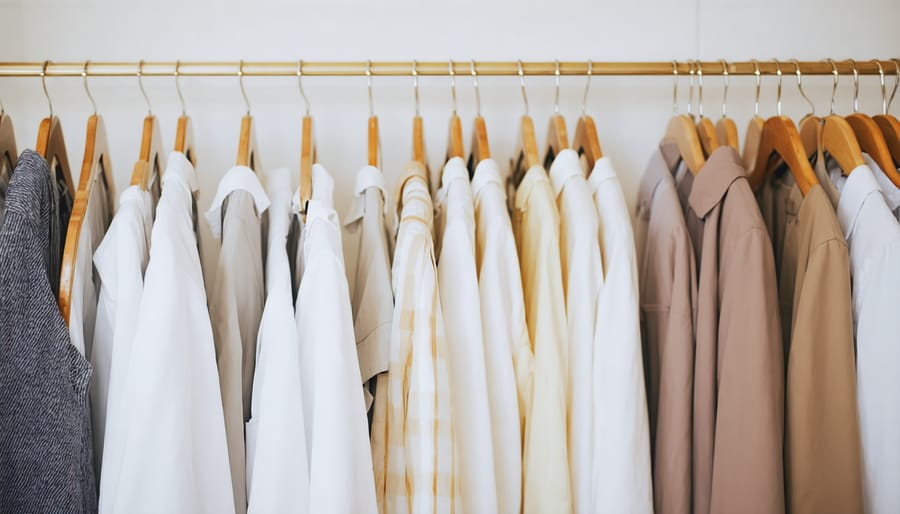
Common Issues and Solutions
Every vintage treasure comes with its own set of challenges, but don’t let that deter you! I’ve learned through years of collecting that most common issues have simple solutions. Missing buttons are an easy fix – just replace them all for a cohesive look, or embrace the mismatched charm that’s becoming increasingly popular.
Delicate fabrics with small tears can be reinforced with iron-on patches from the inside or taken to a skilled tailor. For loose seams, a quick hand-stitch can work wonders, though I always recommend professional repairs for precious pieces. Stubborn stains? Try a gentle mix of white vinegar and water, but always test on an inconspicuous area first.
Vintage zippers can be particularly tricky – if they’re sticky, run a pencil along the teeth to help them glide smoothly. For completely broken zippers, replacement is usually the best option. Musty odors are common in vintage finds, but can typically be eliminated by hanging items outside on a breezy day or using natural deodorizers like baking soda.
Sometimes vintage sizing can be challenging too. Don’t be afraid to have pieces altered to fit perfectly – many vintage garments were made with extra fabric in the seams specifically for this purpose. Remember, these small imperfections and repairs are part of your garment’s story, adding character and charm to each piece.
The Environmental Impact
When you choose vintage clothing, you’re not just making a style statement – you’re making an environmental one too. Fast fashion has become one of our planet’s biggest environmental challenges, with millions of tons of clothing ending up in landfills each year. By embracing vintage pieces, you’re actively participating in one of the most effective forms of fashion recycling.
I remember discovering my grandmother’s 1960s wool coat in her attic – it was not only beautiful but also perfectly wearable after all these years. This experience opened my eyes to how investing in quality fashion creates pieces that truly last, unlike many of today’s disposable garments.
The numbers tell a compelling story: extending the life of clothes by just nine months reduces their carbon, water, and waste footprints by 20-30%. Vintage clothing requires no new resources for production, generates zero manufacturing emissions, and prevents perfectly good garments from entering our waste stream.
But the environmental benefits go beyond just waste reduction. Vintage clothing often features superior craftsmanship and materials that were made to last. These pieces were created before the era of planned obsolescence, meaning they were designed and constructed with longevity in mind. When you choose vintage, you’re also supporting a circular economy that values quality over quantity.
Consider this: every vintage piece you purchase is one less new item that needs to be produced. This means fewer resources consumed, less water used in manufacturing, and reduced chemical pollution from textile production. It’s a simple but powerful way to reduce your fashion footprint while building a unique and characterful wardrobe.
The best part? You don’t have to sacrifice style to be environmentally conscious. Vintage clothing offers endless possibilities for creating contemporary looks while being kind to our planet. It’s a win-win situation that proves sustainable fashion can be both beautiful and responsible.
Investing in timeless vintage pieces isn’t just about building a unique wardrobe – it’s about making thoughtful choices that benefit both your style and the planet. As someone who’s spent years curating my own vintage collection, I can attest to the unmatched quality and character these pieces bring to everyday outfits.
When you choose vintage, you’re not just buying clothes; you’re investing in stories, craftsmanship, and sustainability. These pieces have already proven their durability by standing the test of time, often outlasting their modern counterparts thanks to superior construction and materials. Plus, there’s something incredibly special about wearing a piece that carries decades of history while still looking absolutely stunning today.
From a practical standpoint, vintage clothing offers exceptional value for money. While initial prices might sometimes be higher than fast fashion alternatives, the cost-per-wear often works out significantly lower due to their lasting quality. You’re also likely to find unique pieces that stand out in a world of mass-produced fashion, helping you develop a truly personal style that won’t go out of fashion.
Perhaps most importantly, embracing vintage fashion allows us to participate in sustainable consumption while celebrating the beauty of fashion history. It’s a way to look forward while honoring the past, creating a wardrobe that’s both environmentally conscious and timelessly chic. When you invest in vintage pieces, you’re not just dressing for today – you’re preserving fashion’s legacy for tomorrow.

